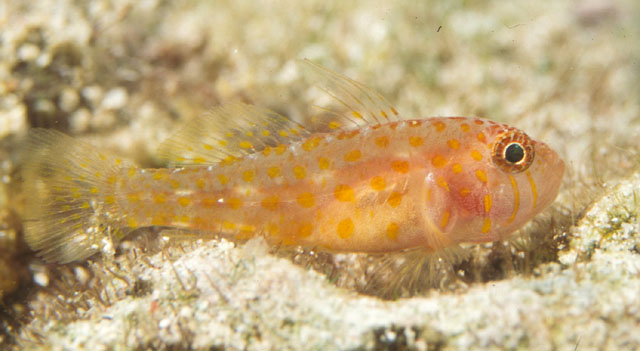| Gobiidae (Gobies), subfamily: Gobiinae |
| 2.21 cm SL (male/unsexed) |
|
reef-associated; marine; depth range 34 - 55 m |
| Western Pacific: Indonesia and Timot-Leste. |
|
Dorsal spines (total): 7-7; Dorsal soft rays (total): 9-9; Anal spines: 1-1; Anal soft rays: 8-8. This species is distinguished by the following characters: scales present on predorsal midline and in a single row of 2-3 scales on upper opercle; absence of scales on cheek; second spine of first dorsal fin elongated, reaching to bases of second to sixth rays of second dorsal fin when adpressed; middle pectoral-fin rays branched; a branched fifth pelvic-fin ray with a vestigial basal membrane; no deep narrow trenches between and behind eyes; colour in life and when fresh includes yellow, orange, or red bars on the cheek and yellow-to-red spots on anterior body which lack discrete dark centers (Ref. 119475). |
| This species is apparently rare and relatively deepwater with specimens collected between 35-70 m. It appears to be a solitary species, with only 1 or 2 specimens collected from each site. Three of the collection sites were steep reef walls exposed to significant current, with individual specimens observed perched upright in small crevices in the coralline-algae-encrusted wall. Two other collection sites were in the mixed coral rubble and sand at the base of steep reef slopes in 35 m depth, with individuals resting on top of medium-sized rubble pieces and disappearing under the rubble when closely approached (Ref. 119475). |
|
Least Concern (LC); Date assessed: 07 September 2021 Ref. (130435)
|
| harmless |
|
Source and more info: www.fishbase.org. For personal, classroom, and other internal use only. Not for publication.

